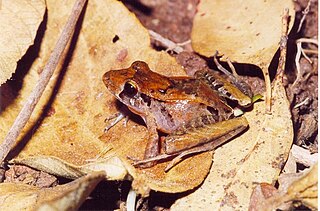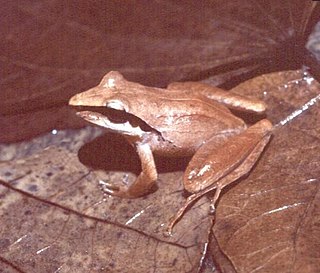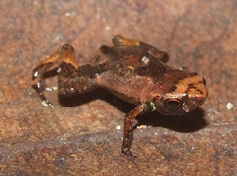
Ischnocnema is a genus of frogs from eastern Brazil and north-eastern Argentina. They comprise the former Eleutherodactylus from this region, but they are closer to Brachycephalus than the "true" Eleutherodactylus. Consequently, they are now placed in their own genus Ischnocnema in the family Brachycephalidae.

Aplastodiscus albosignatus, also known as the Bocaina treefrog, is a species of frog in the family Hylidae. It is endemic to Brazil. Its natural habitats are subtropical or tropical moist lowland forests, subtropical or tropical moist montane forests, and rivers. It is threatened by habitat loss.
Bokermannohyla claresignata is a species of frog in the family Hylidae. It is endemic to Serra do Mar, Brazil. Its natural habitats are subtropical or tropical moist lowland forests, subtropical or tropical moist montane forests, and rivers. It is threatened by habitat loss but is protected by Parque da Serra dos Orgãos, and Parque Nacional da Serra Bocaina.
Dendropsophus berthalutzae is a species of frog in the family Hylidae. It is endemic to southeastern Brazil and occurs in the coastal lowlands and the Serra do Mar in Espírito Santo, Minas Gerais, Rio de Janeiro, São Paulo, and eastern Paraná states. It is named in honor of Bertha Lutz, a Brazilian zoologist and feminist. Common name Bertha's treefrog has been coined for it.
Boana latistriata is a species of frog in the family Hylidae. It is endemic to Brazil and only known from its type locality, Itatiaia National Park, and from Marmelópolis, both in the state of Minas Gerais. The specific name latistriata refers to the wide stripes on the back of this frog.
Ischnocnema gualteri is a species of frog in the family Brachycephalidae. It is endemic to the state of Rio de Janeiro, Brazil, and is only known from the Serra dos Órgãos. Common name Organ Mountains robber frog has been coined for this species.

Ischnocnema hoehnei is a species of frog in the family Brachycephalidae. It is endemic to Brazil. Its natural habitats are subtropical or tropical moist lowland forest and subtropical or tropical moist montane forest. It is threatened by habitat loss.
Ischnocnema lactea is a species of frog in the family Brachycephalidae. It is endemic to Brazil. Its natural habitats are subtropical or tropical moist lowland forest and subtropical or tropical moist montane forest. It is threatened by habitat loss.
Ischnocnema nasuta is a species of frog in the family Brachycephalidae. It is endemic to Brazil. Its natural habitats are subtropical or tropical moist lowland forest, subtropical or tropical moist montane forest, and plantations . It is threatened by habitat loss.
Ischnocnema nigriventris is a species of frog in the family Brachycephalidae. It is endemic to the Serra do Mar in eastern São Paulo state, Brazil. Until a population was found in Bertioga in 2006, the species was only known from the brief species description published in 1925 and a single specimen collected in the 1980s.
Ischnocnema octavioi is a species of frog in the family Brachycephalidae. It is endemic to Brazil. Its natural habitats are subtropical or tropical moist lowland forest and subtropical or tropical moist montane forest. It is threatened by habitat loss.
Ischnocnema pusilla is a species of frog in the family Brachycephalidae. It is endemic to Brazil. Its natural habitat is subtropical or tropical moist lowland forest.
Ischnocnema venancioi is a species of frog in the family Brachycephalidae. It is endemic to Brazil. Its natural habitats are subtropical or tropical moist lowland forest and subtropical or tropical moist montane forest. It is threatened by habitat loss.
Megaelosia goeldii, also known as the Rio big-tooth frog, is a species of frog in the family Hylodidae. It is the only member of the genus Megaelosia. It is endemic to Southeast Brazil and occurs in São Paulo and Rio de Janeiro states. It is named after Émil Goeldi, a Swiss zoologist who worked in Brazil.
Phantasmarana lutzae is a species of frog in the family Hylodidae. It is endemic to Brazil and only known from its type locality in the Itatiaia National Park, Rio de Janeiro state. It is named in honor of Bertha Lutz, a Brazilian zoologist and feminist.
Arcovomer is a genus of frogs in the family Microhylidae. It is monotypic, being represented by the single species Arcovomer passarellii, commonly known as Passarelli's frog. It is endemic to south-eastern Brazil and found in Espírito Santo, Rio de Janeiro, and São Paulo states. Frogs from Espírito Santo may represent another, undescribed species. The name honours Antonio Passarelli who collected the holotype.

Myersiella is a genus of frogs in the family Microhylidae. It is monotypic, being represented by the single species, Myersiella microps. It is endemic to southeastern Brazil and occurs in Espírito Santo, Rio de Janeiro, southeastern Minas Gerais, and southeastern São Paulo state. The genus name honors George S. Myers. The genus is sometimes known as the elongated frogs, while the sole species is known as Rio elongated frog.

Brachycephalus nodoterga, also known as the Serra Cantareira saddleback toad, is a species of frog in the family Brachycephalidae. It is endemic to the eastern São Paulo state of southeastern Brazil, and only known from five locations in Atlantic rainforest at altitudes of 700–900 m (2,300–3,000 ft).

The Brazilian gold frog, also known as Izecksohn's toad or flea-frog, is a very small species of frogs in the family Brachycephalidae. It is endemic to southeastern Brazil and is known from the central part of the state of Rio de Janeiro and from Serra das Torres in extreme southern Espírito Santo.

Brachycephalus pulex, also known as the Brazilian flea toad and the Serra Bonita flea toad, is a species of small frogs in the family Brachycephalidae. It is one of more than 35 named species within the genus Brachycephalus. It has been suggested to represent the smallest known vertebrate, with an average snout–vent length of 7.10 millimetres (0.280 in) in mature males.








